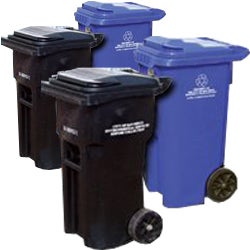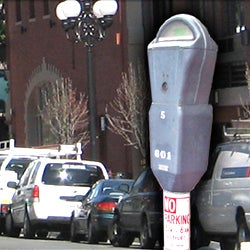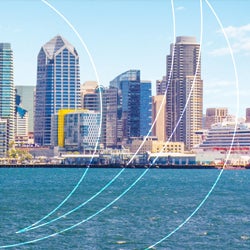Permit Applications
Alarm Permits
The City of San Diego requires permits for burglary, robbery, fire, and harmful gas alarm systems for both residential and commercial properties. Read the Frequently Asked Questions about alarm system permits, and the Department policy on the process for administering the Fire/Harmful Gas Alarm System permits and how and when penalty mitigation would be appropriate. You may apply and pay your alarm permit fees online; or download, fill-in and print a downloadable application.
For information about the False Alarm Program click here.
Monitored Fire Alarm Permit
The City of San Diego Fire-Rescue Department requires a permit for monitored fire and/or harmful gas alarm systems for both residential and commercial properties. A fire alarm permit is $18.00 for 24 months and may be obtained using one of the following options:
Apply or Pay for Fire Alarm Permits
San Diego Fire-Rescue Attn: Fire Alarms Clerk 525 B Street Suite 300 San Diego, CA 92101Note: This is a separate permit requirement from the monitored security alarm permit requirement with the San Diego Police Department.
The installation or modification of a fire alarm system requires a Fire Permit from the Development Services Department.
New Construction
New construction and tenant improvements of existing buildings are also reviewed, but are submitted under the City's Development Services Department online permitting system with the exception of the applications listed below.
DSA/HCAI Local Fire Authority Review
Construction plans for public school construction and certain other state-funded building projects are reviewed to ensure that plans, specifications, and construction comply with California's codes (Title 24 of the California Code of Regulations). The majority of DSA's plan review and construction oversight focuses on new construction and alteration projects for California K–12 schools and community college districts. DSA’s plan review ensures the project’s compliance with code requirements related to structural safety; fire and life safety; accessibility; and, sustainability.
Emergency Responder Radio Coverage System
All new buildings must meet the minimum performance requirements for in-building, emergency responder communication system coverage. Please refer to the Where Required section of this webpage for additional information.
Upon completion of building construction, a radio coverage test demonstrating acceptable coverage levels shall be completed and submitted to SDFD for approval. If the test does not meet coverage requirements, an Emergency Responder Radio Coverage System (ERRCS) shall be installed.
A fire permit is required for the installation of all ERRCS to comply with the minimum standards necessary to safeguard public health, safety, and welfare. In addition, a fire permit is required prior to modification of (altering, adding, or replacing) any components of an ERRCS. Maintenance of the system performed in accordance with California Fire Code and SDFD ERRCS Guidelines is not considered a modification and does not require a permit pursuant to Section 510.3 in the California Fire Code.
- If you are applying for proof through testing of acceptable emergency responder radio coverage, please expand and complete the Apply for Proof of Acceptable Coverage section of this webpage. Failure of an acceptable coverage compliance test will require the installation of an ERRCS.
- If you are applying for an ERRCS Installation Permit, please expand and complete the Plan Your Project and Apply for ERRCS Permit sections of this webpage.
- If you are submitting an Acceptance Test report for an installation that was previously approved by City of San Diego Department of Information Technology – Wireless Technology Services Division, please utilize the Apply for Proof of Coverage section.
- NOTE: An SDFD associate inspection shall be required to verify the installation and results of the acceptance test report.
Where Required
New Buildings: All new buildings must meet the minimum performance requirements for in-building, emergency responder communication system coverage. Upon completion of building construction, a radio coverage test shall be conducted per the specific requirements of CFC 510, and if the test fails, an Emergency Responder Radio Coverage System (ERRCS) shall be installed.
Considerations should be made to install conduit during building construction to accommodate ERRCS coaxial cables if testing indicates a system is needed to provide acceptable coverage after building construction is completed.
- All new high-rise buildings must be provided with an Emergency Responder Radio Coverage System (ERRCS). A wired phone-jack two-way communication system shall not be permitted to be installed in new high-rise buildings in lieu of the required ERRCS.
- Low-rise buildings meeting ANY of the following conditions must submit a radio coverage test certified by a licensed FCC General Radio Operator or an approved third-party testing agency demonstrating acceptable coverage levels.
- Buildings 3 or more stories above grade plane
- Total building area exceeds 20,000 sq. ft.
- Building contains multiple stories below grade or a basement exceeding 2,500 square feet
Exceptions:
- Group R-3 occupancies
Existing Buildings: Existing buildings must comply with these requirements under the following conditions.
- Where a previously required two-way wired fire department communication system is removed.
- Where building permits are required for a change of use or occupancy in accordance with CFC 102.3. Radio coverage shall not be required if the building has an existing operational wired phone-jack system.
- Existing high-rise buildings without an existing wired fire department communication system (phone-jack system) are required to conduct a radio test to verify acceptable radio coverage. If the radio test fails, an ERRCS shall be installed within three (3) years of the test date.
Apply for ERRCS Permit
Plans: The Emergency Responder Radio Coverage System (ERRCS) shall be designed and installed in accordance with SDFD ERRCS Guidelines, with plans conforming to the requirements of APPENDIX B.
Acceptance Test: Upon completion of both building construction and ERRCS installation, the system is required to be tested to ensure that the two-way coverage on each floor of the building is not less than 95% and 99% of critical areas. Coverage shall be based on operation with fire door(s) closed. The test procedure shall follow the requirements of CFC 510.5.4.
- NOTE: Acceptance testing is required to be performed by a third-party qualified testing entity, not employed by or related to the ERRCS installation contractor.
All testing shall be conducted by a licensed FCC General Radio Operator with an approved certificate of in-building system training. All RF measurements are to be made using equipment with proof of current calibration. Downlink RF measurements are to be taken using control channels. DAQ shall be measured using an instrument which decodes the APCO Project-25 bitstream and provides a SINR or SNR measurement. A passing SNR or SINR is 20 dB or greater, and a passing BER is no greater than two percent.
Successful Acceptance Test reports shall be formatted to meet the criteria required in SDFD ERRCS Guidelines APPENDIX C, and submitted to SDFD Fire Plans Review personnel.
Inspection: An SDFD associated inspection shall be required to verify the installation and results of the acceptance testing report. After SDFD’s inspection of the ERRCS installation, a stamped/approved version of the acceptance report will be returned to the testing contractor. This report shall then be uploaded to The Compliance Engine by that contractor.
Apply for Proof of Acceptable Coverage
Upon completion of building construction, testing for proof of acceptable coverage is required to ensure that the two-way coverage on each floor of the building is not less than 95% or 99% for critical areas. Coverage shall be based on operation with fire door(s) closed. The test procedure shall follow the requirements of CFC 510.5.4.
All testing shall be conducted by a licensed FCC General Radio Operator with an approved certificate of in-building system training. All RF measurements are to be made using equipment with proof of current calibration. Downlink RF measurements are to be taken using control channels. DAQ shall be measured using an instrument which decodes the APCO Project-25 bitstream and provides a SINR or SNR measurement. A passing SNR or SINR is 20 dB or greater, and a passing BER is no greater than two percent.
An SDFD associated operational inspection may be required to verify the results of the test.
Failure of proof of acceptable coverage will require the installation of an ERRCS and be subject to ERRCS Permit fees.
It is strongly recommended that considerations be made to install conduit during building construction to accommodate ERRCS cables if testing indicates a system is needed to provide acceptable coverage.
Successful Proof of Acceptable Coverage reports shall be formatted to meet the criteria required in SDFD ERRCS Guidelines APPENDIX D.
Special Events
The Special Services section is responsible for special events such as Comic-Con, the Thunder Boat Races, street fairs, trade shows, high school Grad Nights; events at large public assemblies like Petco Park and the Sports Arena; events in locations where large number of people do not normally gather; and events in many other settings.
Special Events Guidelines
Special Events Guidelines (PDF) This document describes many of the events requiring a permit and outlines the procedure for obtaining the permit.
Some events require only a fire permit, while others require a permit from other City departments, including the Office of Special Events.
Regulation is based on the type of event, the setting, and the potential risk to the participants and the surrounding community.
Questions may be addressed to Special Services at 619-533-4388.
Special Events Permits
The Application for a Single Event Permit can be completed online, and can be emailed to sdfdevents@sandiego.gov, mailed, or carried in to our office. The completed permit package shall be submitted at least 10 business days prior to the event. A $300 fee will be charged for applications submitted less than 10 business days prior to the event. Applications received less than 5 business days before an event may not be reviewed.
San Diego Fire-Rescue DepartmentCommunity Risk Reduction Division Attn: Special Events 525 B Street, Suite 300
San Diego, CA 92101
Mail Station 601
Information Bulletins
Each of the following provides information to familiarize promoters, sponsors, and vendors with information about specific types of events. For questions which have not been covered here, contact 619-533-4388.
Technical Services
The Technical Services section is charged with the safe installation of hazardous materials in bulk and any associated piping or equipment. Regulation is provided through the permit process, with permit amounts based on International Fire Code requirements, Section 105, Permits.
What Requires a Permit?
- Installation and removal of:
- Above-ground tanks for fuels, oils and other lubricants, chemicals and flammable or combustible liquids;
- Below-ground tanks for fuels, oils and other lubricants, chemicals and flammable or combustible liquids;
- Re-pipe or modification to hazardous systems or installations;
- Installation of:
- Liquid Propane Gas (LPG): Operation permit required for storage or use of LPG.
- Compressed Natural Gas (CNG): Fuels not otherwise used for household use.
- Compressed Gas: Flammable, toxic, corrosive, pyrophoric, oxidizing, inert, refrigerants, etc.
- Medical gas: Anesthetic and other gases used in medicine (including veterinary medicine) which are not otherwise regulated by the State of California (i.e. schools and institutions).
- Cryogens: Flammable, toxic, corrosive, pyrophoric, oxidizing, inert, etc.
- Site/Soil Remediation: When any device is installed for the remediation of a site, or soil stockpiled on a site, in which hazardous liquids or vapors are recovered or used during the process, a permit is required.
Permit Application
- The Hazardous Materials Permit Application is a form listing owners, operators, contractors and information related to the installation.
- All portions must be filled in, including a signature. Proof of insurance is required to be provided along with the application. A check covering total Hazardous Materials Permit Fees, payable to the "City Treasurer," is required at the time of application.
- Mail or deliver by appointment only. Call (619) 533-4477 to schedule an appointment.
- San Diego Fire-Rescue
Attn: Technical Services
525 B Street Suite 300
San Diego, CA 92101
- San Diego Fire-Rescue
Plan Review
- The plan review encompasses a thorough review of submitted plans, checking for compliance with current applicable codes.
- Submittals must include all pertinent information both in specification and plan view; details and cut-sheets for any equipment; and the materials, manner and method of installation.
- Submit two full size and one reduced (11 x 17) set of plans. The full sized sets will be stamped and returned when review is completed.
- As-builts will not be accepted.
- When changes are made to the installation in the field, the changes must be pre-approved.
- When required, a referral will be made to Development Services for occupancy classification and/or building permits.
- Expedited plan review is available. See information below.
- When plan review has been completed, notification will be sent and plans may be picked up by appointment only. Please call (619) 533-4477 to schedule a pickup appointment.
Expedited Plan Review
- Upon request plan review can be expedited by submitting a Request for Technical Services Overtime Inspection/Plan Review form along with the Hazardous Permit Application.
Inspection
- Field inspections of the installation during various stages of construction are required.
- The number of inspections is based on the type of installation.
Overtime Inspections
- Upon request an overtime inspection may be performed before or after regular business hours and weekends.
- An additional fee is charged.
- You may download a Request for Technical Services Overtime Inspection/Plan Review (PDF).























